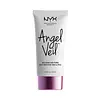What's inside
What's inside
 Key Ingredients
Key Ingredients

 Benefits
Benefits

 Concerns
Concerns

No concerns
 Ingredients Side-by-side
Ingredients Side-by-side

Caprylyl Methicone
Skin ConditioningWater
Skin ConditioningPEG-12 Dimethicone/PPG-20 Crosspolymer
Phenethyl Disiloxane
Skin ConditioningPolysilicone-11
Cyclopentasiloxane
EmollientIsodecyl Neopentanoate
EmollientVinyl Dimethicone/Methicone Silsesquioxane Crosspolymer
Cyclomethicone
EmollientPEG-10 Dimethicone
Skin ConditioningSodium Hyaluronate
HumectantPseudoalteromonas Exopolysaccharides
Skin ConditioningSodium Salicylate
PreservativeAdipic Acid/Neopentyl Glycol Crosspolymer
Methyl Methacrylate/PEG/PPG-4/3 Methacrylate Crosspolymer
Tocopherol
AntioxidantAcrylamide/Sodium Acryloyldimethyltaurate Copolymer
Emulsion StabilisingSilica Dimethyl Silylate
EmollientLaureth-12
EmulsifyingPolyacrylate Crosspolymer-6
Emulsion StabilisingIsohexadecane
EmollientPolysorbate 80
EmulsifyingDimethicone
EmollientCyclohexasiloxane
EmollientCetearyl Dimethicone Crosspolymer
Vp/Va Copolymer
Cyclotetrasiloxane
EmollientAmodimethicone
Hydroxypropyl Methylcellulose
Emulsion StabilisingCitric Acid
BufferingButylene Glycol
HumectantHexylene Glycol
EmulsifyingEthylhexylglycerin
Skin ConditioningPhenoxyethanol
PreservativeChlorphenesin
AntimicrobialCaprylyl Methicone, Water, PEG-12 Dimethicone/PPG-20 Crosspolymer, Phenethyl Disiloxane, Polysilicone-11, Cyclopentasiloxane, Isodecyl Neopentanoate, Vinyl Dimethicone/Methicone Silsesquioxane Crosspolymer, Cyclomethicone, PEG-10 Dimethicone, Sodium Hyaluronate, Pseudoalteromonas Exopolysaccharides, Sodium Salicylate, Adipic Acid/Neopentyl Glycol Crosspolymer, Methyl Methacrylate/PEG/PPG-4/3 Methacrylate Crosspolymer, Tocopherol, Acrylamide/Sodium Acryloyldimethyltaurate Copolymer, Silica Dimethyl Silylate, Laureth-12, Polyacrylate Crosspolymer-6, Isohexadecane, Polysorbate 80, Dimethicone, Cyclohexasiloxane, Cetearyl Dimethicone Crosspolymer, Vp/Va Copolymer, Cyclotetrasiloxane, Amodimethicone, Hydroxypropyl Methylcellulose, Citric Acid, Butylene Glycol, Hexylene Glycol, Ethylhexylglycerin, Phenoxyethanol, Chlorphenesin
Ingredients Explained
These ingredients are found in both products.
Ingredients higher up in an ingredient list are typically present in a larger amount.
Cyclohexasiloxane is a type of silicone more commonly known as D6. It is an emollient and solvent.
Cyclohexasiloxane is used to evenly distribute ingredients throughout the product. When applied to the skin, Cyclohexasiloxane evaporates and leaves behind a silky feel.
As an emollient, it can help the skin feel soft and hydrated. It is also used to reduce frizz in hair products.
Learn more about CyclohexasiloxaneCyclopentasiloxane, or D5, is a silicone used to improve texture of products and trap moisture.
D5 is considered lightweight and volatile. Volatile means it evaporates quickly after application. Once evaporated, D5 leaves a thin barrier that helps keep skin hydrated.
It is also an emollient. Emollients help soften the skin and prevent water loss. Silicones create a silky texture in products. D5 helps other ingredients become more spreadable.
Studies show D5 is safe to use in skincare products. We recommend speaking with a skincare professional if you have concerns.
Learn more about CyclopentasiloxaneWe don't have a description for Laureth-12 yet.
Peg-10 Dimethicone is silicone with conditioner and emulsifier properties. It mostly acts as an emollient in skincare and and humectant in haircare.
According to the manufacturer, acidic formulations decrease the stability of this ingredient. It works best in neutral or near neutral formulations.
Phenoxyethanol is a preservative that has germicide, antimicrobial, and aromatic properties. Studies show that phenoxyethanol can prevent microbial growth. By itself, it has a scent that is similar to that of a rose.
It's often used in formulations along with Caprylyl Glycol to preserve the shelf life of products.
Polysilicone-11 is a film-forming silicone that creates a non-tacky and matte finish on the skin. It's commonly used to improve texture, absorb excess oil, and help active ingredients spread evenly.
Due to its "rubber-like" structure, it stays on the skin's surface instead of being absorbed. On the skin, it creates a flexible layer that enhances wearability and stability.
This silica is mainly used to thicken oils and suspend particles in oils. It is not water soluble.
According to the manufacturer, it:
The manufacturer also claims this ingredient to be useful in makeup.
In lipstick formulations, this ingredient improves color payoff, reduces pigment settling, and reduces oil bleeding. This ingredient also improves the grip of powder products such as dry shampoos.
Learn more about Silica Dimethyl SilylateTocopherol (also known as Vitamin E) is a common antioxidant used to help protect the skin from free-radicals and strengthen the skin barrier. It's also fat soluble - this means our skin is great at absorbing it.
Vitamin E also helps keep your natural skin lipids healthy. Your lipid skin barrier naturally consists of lipids, ceramides, and fatty acids. Vitamin E offers extra protection for your skin’s lipid barrier, keeping your skin healthy and nourished.
Another benefit is a bit of UV protection. Vitamin E helps reduce the damage caused by UVB rays. (It should not replace your sunscreen). Combining it with Vitamin C can decrease sunburned cells and hyperpigmentation after UV exposure.
You might have noticed Vitamin E + C often paired together. This is because it is great at stabilizing Vitamin C. Using the two together helps increase the effectiveness of both ingredients.
There are often claims that Vitamin E can reduce/prevent scarring, but these claims haven't been confirmed by scientific research.
Learn more about TocopherolWater. It's the most common cosmetic ingredient of all. You'll usually see it at the top of ingredient lists, meaning that it makes up the largest part of the product.
So why is it so popular? Water most often acts as a solvent - this means that it helps dissolve other ingredients into the formulation.
You'll also recognize water as that liquid we all need to stay alive. If you see this, drink a glass of water. Stay hydrated!
Learn more about Water